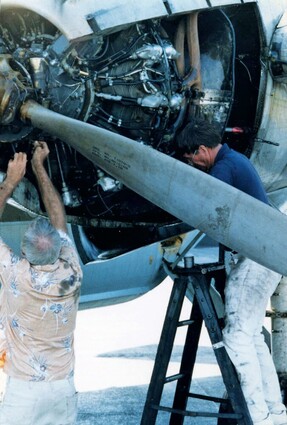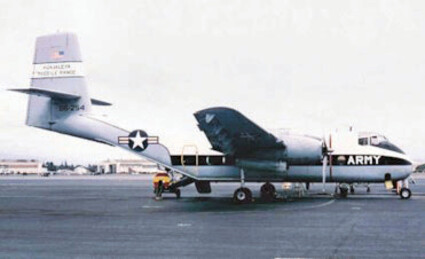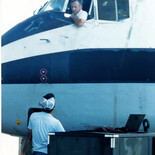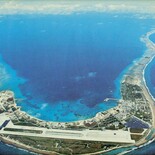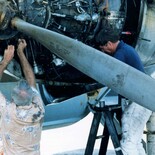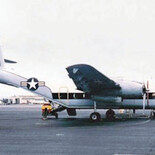Flying Caribou from Kwajalein to Mojave
Short Flights
September 2, 2023
I was talking with our friend Dan Yost recently and we were remembering some of his Plane Crazy Saturday presentations.
He flew C-7 Caribou in Vietnam while serving in the U.S. Air Force and loved the flying characteristics of that particular aircraft. He also flew thousands of hours in the B-47 Stratojet. He gave a detailed presentation on his Vietnam sorties several years ago.
Yost graduated from the U.S. Air Force Flight School in November 1956 and was assigned to B-47s at Schilling AFB in Salina, Kansas from April 1957 to June 1965. He flew B-47s for eight years. Two years as Co-Pilot and six years as an Aircraft Commander. (He gave a Plane Crazy Saturday presentation about the flying characteristics of the B-47 in Sept. 2015.)
From 1965-1967, he was stationed at Perrin AFB in Denison, Texas flying T-33s and their one and only C-47. He was sent to Vietnam in May 1968 and was assigned to fly the C-7A Caribou.
This reminded me of when Al and I went to Kwajalein Atoll with Al's partners to get seven DeHavilland C-7 (DHC-4) aircraft ready to ferry home to the states.
Have you ever dreamed of going to the South Seas? My husband Al always had that dream, so when we had the opportunity to go to Kwajalein Atoll in 1986, to retrieve seven C-7 Caribou aircraft, we jumped at the chance!
I had no idea what I was getting into, but was always up to a new adventure. Al had two partners at the time and they had made some trades with the Air Force Museum in Dayton, Ohio. That's where the seven Caribou came into the picture.
Lots of security and background checks, of course. It is still an active U.S. Army base.
As you may know Kwajalein Atoll was a battlefield in WWII in 1944, but presently is an important missile test facility for the Dept. of Defense and now carries the name of Ronald Reagan Ballistic Missile Defense Test Site (RTS) because SDI (Strategic Defense Initiative) was born there.
The missiles fired from Vandenberg AFB go to the U.S. Army Reagan Test Site at Kwajalein and land in the lagoon. The scientists who worked at Kwaj wanted to get rid of the C-7's and their fire-breathing radial engines, in favor of Short 330 aircraft with turboprop engines.
The C-7 or DHC-4 (DeHavilland Aircraft of Canada, Ltc.) carried a military designation of C-7 Caribou. It is a wonderful STOL (short take-off and landing) aircraft and is powered by two Pratt and Whitney Twin Wasp R-2000-7M2 engines. It has a maximum gross weight of 28,500 pounds and can carry 31 passengers or 25 fully equipped paratroops.
One of the pilots we hired to help ferry the Caribou back to California said the C-7 had Herculean capabilities if necessary. He flew C-7's in Southeast Asia and told of emergency evacuations where he brought out 59 indigenous personnel in his C-7. It was a rugged aircraft designed to get in and out of unimproved strips and did it extremely well, according to the pilot.
Two of the aircraft were sold "as is, where is" and they were flown to California by the new owners.
We hired extra mechanics and spent five weeks at Kwajalein preparing the airplanes for flight. Pilots familiar with the aircraft and the route across the Pacific were brought in and the first two aircraft departed Kwajalein on Jan. 26. The aircraft were equipped with extra fuel tanks and extra barrels of oil that could be pumped to the engines during flight.
The first team choose to go to Midway Island on the first leg of the trip because head winds prevented a straight route to Hawaii. The flight took 10.5 hours. They headed for Honolulu the next day, which took 8.5 hours from Midway and the flight to Oakland from Hawaii took 11.5 hours.
Al was a crewmember on ship No. 3 and they flew from Kwaj to Honolulu in 15-hours, 45-minutes. He told me that he slept on one of the fuel bladders that was in the back of the aircraft.
The three pilots traded off navigation and pilot duties and one would try to sleep. Al flew back to Kwajalein the next day and another pilot joined the crew in Hawaii for the flight on to Oakland. I remember it was Valentine's Day.
It's a beautiful base and you know you are in the South Pacific! The humidity is so high it rains every day and it's a horizontal rain because the winds are always about 20 mph, but the temperature is warm and lovely. There are lots of palm trees and beautiful tide pools to find sea critters.
All planes made it safely to Oakland and then to Mojave, praise the Lord!


